Tartous (ST) Located about 250km away From Damascus, Safita is a north-western city situated to the southeast of Tartous and to the northwest of Krak des Chevaliers. The city has a population of 33,000. It is located on the top of 3 hills and the valleys in between them, on the coastal mountain ranges of Syria. It was important during the crusades, and was inhabited by the Knights Templar of the castle Chastel Blanc while part of the County of Tripoli.


Ancient History
The city has been inhabited since the times of the Phoenicians, and several archaeological discoveries have been made, including Phoenician and Canaanite settlements.

 Crusades
Crusades
In 1102, Raymond IV of Toulouse began to take the land of the Banu Ammar’s Emirs of Tripoli. A four-year siege on Tripoli resulted in full control of the city and many lands surrounding it, including Safita. Mamluk Sultan Qalawun captured the county in 1289, and Safita was once again under Muslim rule.
Chastel Blanc
 Chastel Blanc (called by the natives, ‘the White tower’) was built by the Knights Templar on already existing fortifications. There were other fortifications in Safita in addition to the tower. However, the tower is the only fortification that has lasted all this time even surviving an earthquake in 1202. The tower was built on the highest of Safita’s three hills, and offers a commanding view of the surrounding countryside. It has a height of 30 meters, a width of 50 meters, a length of 70 meters.
Chastel Blanc (called by the natives, ‘the White tower’) was built by the Knights Templar on already existing fortifications. There were other fortifications in Safita in addition to the tower. However, the tower is the only fortification that has lasted all this time even surviving an earthquake in 1202. The tower was built on the highest of Safita’s three hills, and offers a commanding view of the surrounding countryside. It has a height of 30 meters, a width of 50 meters, a length of 70 meters.
The Tower
The structure was constructed with limestone blocks, and the flooring is covered with big stone plates. The tower has two floors, the ground floor contains the chapel of St. Michael, which has survived from the Crusader era. The second floor, which can be reached by a flight of partially destroyed stairs, contains many small windows that were used by archers to defend the tower. The ceiling of the tower is supported by many robust columns. There is a big bell on the western wall and its sound can be heard up to 5 kilometers from Safita. Another flight of stairs are found on the second floor, that can be taken to the roof of the tower. From the roof, one can see the snow-covered mountains of Lebanon, as well as Tripoli. The Mediterranean sea and the Krak des Chevaliers are also visible. During French colonialism, efforts were made to restore the tower, causing great discomfort to the villagers that lived very close to it.
Haifaa Mafalani

